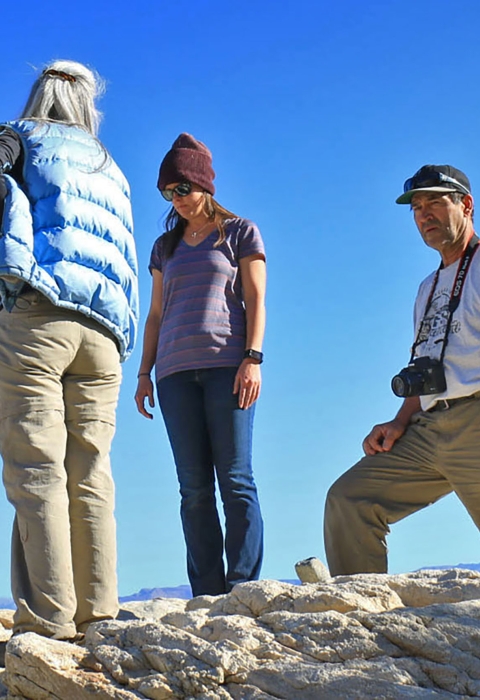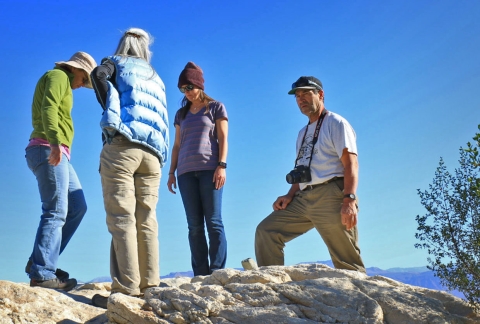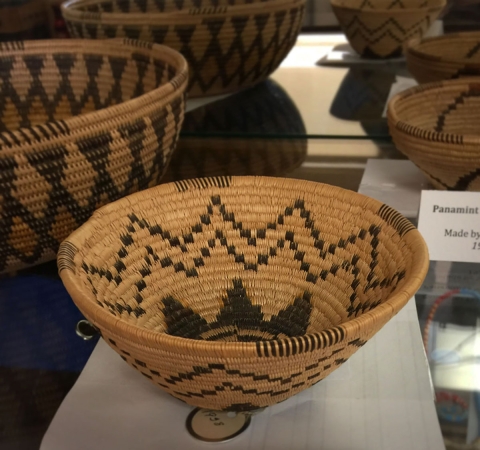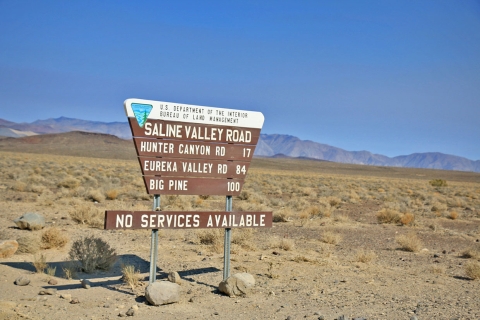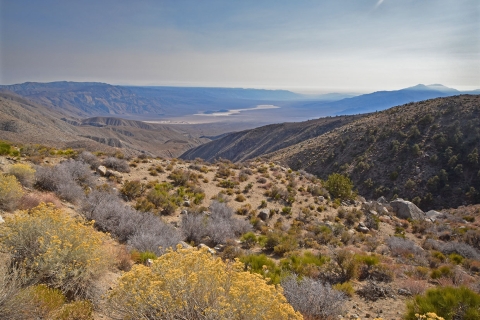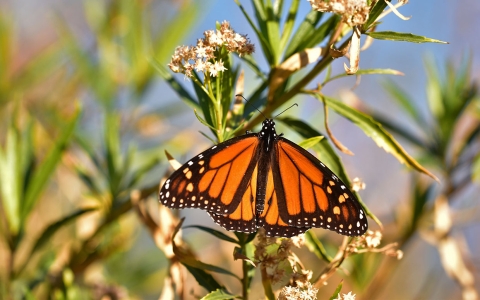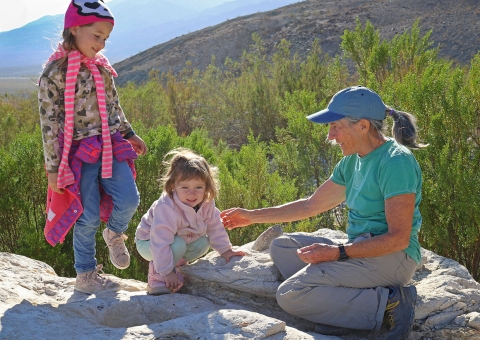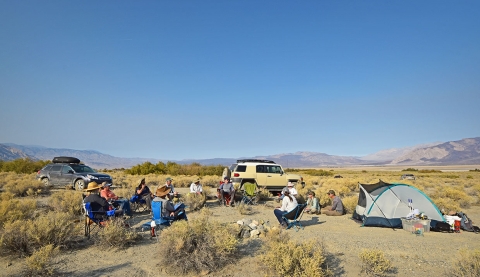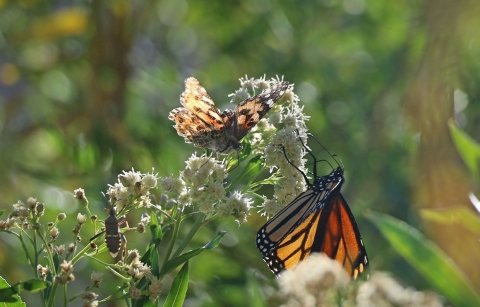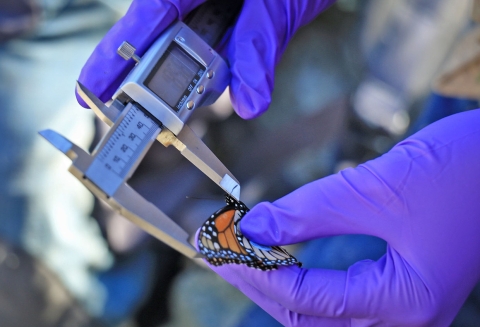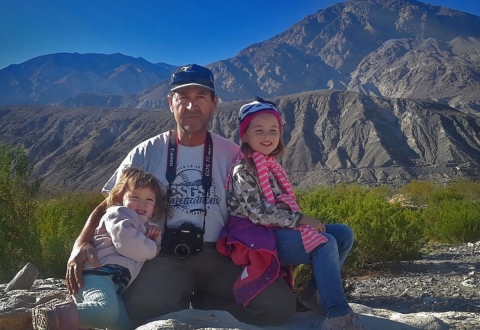Surrounded by blue skies and the vast open desert, Spike Jackson, a tribal member and environmental director for the Timbisha Shoshone Tribe, described a large basket, woven with ornate geometric patterns, and orange and black butterflies.
“The basket was handcrafted by my great-great aunt, who lived here (Saline Valley) at one time,” Jackson said. “The butterflies must have been significant to my ancestors, but I don’t know why and I’d like to know.”
The Timbisha Shoshone, a federally recognized tribe, historically occupied millions of acres across Eastern California and Western Nevada, including the infamous Death Valley and an adjacent valley, known as Saline Valley.
Inspired by a chance to visit the home of his ancestors and see the butterflies adorning his family’s handwoven basket, Jackson and his family volunteered to monitor monarchs as part of the second annual Saline Valley Monarch Count.
The Saline Valley Monarch Count is a citizen-science based effort to survey monarch butterflies overwintering in the slick-rock canyons that drain into Saline Valley. It was initiated by Rachel Williams, wildlife biologist for the U.S. Fish and Wildlife Service in Flagstaff, Arizona, after Williams learned of monarch surveys conducted nearly every year from 1976 to 2008 by a local naturalist Derham Giuliani.
In some years, Giuliani recorded more than 1,000 monarchs.
Captivated by the resilience of monarchs, Williams brought the passion for helping them into her personal life. When she wasn’t at work, Williams was in the valley searching for butterflies. After exploring the canyon and discovering monarchs, Williams decided to coordinate a larger volunteer-based monarch survey to cover more monitoring ground.
In the winter of 2017, she led a group of 34 citizen-scientists who observed 145 monarchs across five canyons in Saline Valley.
In November 2018, Jackson, his wife Eileen, and their daughters, Coco and Arrow, drove down a remote dirt road, passing by pinyon and juniper trees atop Hunter Mountain, before descending into Saline Valley and parking near the base of Hunter Canyon.
“I’ve been to Hunter Canyon before, but never with the knowledge that this is where my great-grandmother, Mary Wrinkle, and my great-great aunt Mamie, grew their food.
There are stories that they grew squash, melons and alfalfa in this canyon. Now I get to see it, and my children get to see it for the first time,” Jackson said, nodding to his daughters.
When Jackson was growing up, his grandmother would bring the family to Hunter Mountain, which is visible from the Saline Valley floor. Hunter Mountain is carpeted in pinyon juniper, and there the family harvested pine nuts.
“That’s where we went, every year like clockwork, to pick the pine nuts. My grandmother was full-blooded Shoshone. She cooked pine cones underground to prepare the pine nuts for us,” Jackson said, but he didn’t know the cultural significance of the area until later in life.
He’s now grateful his grandmother shared this tradition with him and appreciates the incredible 50-mile round-trip journey his ancestors regularly took to harvest pine nuts, walking from the floor of Saline Valley to the peak of Hunter Mountain at 7,100 feet above sea level.
“This was the last place my great-grandmother existed, they were the last of the Shoshone to live here, before they were told to get out,” he said, “from here they went to Darwin, and before that, I don’t have knowledge of where they were. I wish I knew. And I wish I knew her. Thousands of years of knowledge has been lost. I do everything I can to relearn the history. That is why I’m here. I hope we see the butterflies,” he said.
Monarchs in Saline Valley must be counted at dawn, before temperatures rise and monarchs begin to move to avoid double counting. Reaching the monarchs before daybreak requires an overnight stay in the valley.
This year, 17 volunteers including Jackson and his family, camped in the wilderness, hearing only the sounds of wild burros and wind.
Before sunrise, the group including Williams and Jackson’s family, hiked to Hunter Canyon in search of monarchs. In the cool of the early morning, the butterflies were motionless and resembled willow and cottonwood leaves.
Once the sun emerged from behind the mountains, they began fluttering through the air, prompting Jackson’s amazement. “I can't believe they’re really here!” The group counted 13 monarchs that day. After the survey, Williams netted a single monarch to demonstrate to the volunteers how to tag a butterfly properly.
Williams pointed to a mitten-shaped cell on the butterfly’s hindwing, showing Jackson’s oldest daughter Coco, where to place the tag. “Hopefully this monarch will be seen somewhere else so we can learn more about the Saline Valley monarchs. We still don’t know where these butterflies are coming from, where they go or how long they stay in the valley,” Williams said. “At this point, it all remains a mystery.”
Williams then gathered data on the monarch including sex, weight and wingspan before placing the butterfly in Coco’s palm for release. “My hope is that she chooses a path to protect our environment," Jackson remarked, as Coco smiled, held out her hand and let the monarch return to the sky.
Volunteers monitored monarchs in Saline Valley through January 2019 in hopes of observing fluctuations in the population over the course of the overwintering season. Across the west, monarchs are declining. Data collected in Saline Valley was submitted to the annual Western Monarch Thanksgiving Count, led by Xerces Society for Invertebrate Conservation, and will help scientists learn more about the butterfly’s conservation status.
Xerces Society recently announced the results of the 2018 volunteer count, which show that monarch numbers are critically low this year. The overwintering population has decreased by 85.2 percent since last year’s count and by 99.4 percent since the 1980s. The U.S. Fish and Wildlife Service supports the Western Monarch Thanksgiving Count and is actively working with partners across the western landscape to restore monarch butterfly habitat and develop management strategies to boost the monarch population.
